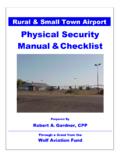Transcription of Small Business Handbook - Occupational Safety …
1 - Small Business Handbook Small Business Safety and health Management Series OSHA 2209 02R 2005 Employers are responsible for providing a safe and healthy workplace for their employees. OSHA s role is to promote the Safety and health of America s working men and women by setting and enforcing standards; providing training, outreach and educa-tion; establishing partnerships; and encouraging continual improvement in workplace Safety and health . About this Handbook This Handbook is provided to owners, propri-etors and managers of Small businesses by the Occupational Safety and health administration (OSHA), an agency of the Department of Labor. For additional copies of this publication, write to the overnment Printing Office, ( PO), Superintendent of Documents, Mail Stop SDE, 732 N.
2 Capitol Street, NW, Washington, DC 20401, or call the OSHA Publications Office at (202) 693-1888, or fax (202) 693-2498 for ordering infor-mation. Please note that the entire text of the Small Business Handbook is available on OSHA s website at The Handbook should help Small Business em-ployers meet the legal requirements imposed by the Occupational Saf ty and H alth Act of 1970 (the Act), and achieve an in-compliance status before an OSHA inspection. An excellent resource to accom-pany this information is OSHA s Safety and health Program Management uidelines, (54 Federal Register 3904-3916, January 26, 1989), also avail-able on OSHA s website. This Handbook is not a legal interpretation of the provisions of the Act and does not place any addi-tional requirements on employers or employees.
3 Employers cannot be cited under the eneral Duty Clause in Section 5(a)(1) of the Act for failure to fol-low recommendations in this Handbook . The materials in this Handbook are based upon Federal OSHA standards and other requirements in effect at the time of publication and upon generally accepted principles and activities within the job Safety and health field. They should be useful to Small Business owners or managers and can be adapted easily to individual establishments. It is important to point out that 24 states, Puerto Rico and the Virgin Islands operate their own OSHA-approved Safety and health programs under Section 18 of the Act. While the programs in these State Plan States may differ in some respects from Federal OSHA, this Handbook can be used by employers in any state because the standards imposed by State Plan States must be at least as effective as Federal OSHA standards.
4 A list of states that operate their own Safety and health pro-grams can be found on OSHA s website at Material in this publication is in the public domain and may be reproduced, fully or partially, without permission. Source credit is requested but not required. This information will be made available to sen-sory impaired individuals upon request by voice phone (202) 693-1999 or teletypewriter (TTY) (877) 889-5627. Please Note: The Small Business employer seeking information on procurement or contracting with the Department of Labor or OSHA should contact the Department of Labor s Office of Small Business Programs, 200 Constitution Avenue, NW, Room C-2318, Washington, DC 20210. Small Business Handbook Occupational Safety and health administration Department of Labor OSHA 2209-02R 2005 Department of PREFACE 4 Office of Small Business Assistance 4 Cooperative Programs 4 State Plans 4 Office of Training and Education 4 OSHA s Website Safety and health Add Value 5 INTRODUCTION: The Value of a Safety and health Management System 6 A Profit and Loss Statement 6 Developing a Profitable Strategy for Handling Occupational Safety and health 6 A FOUR-POINTWORKPLACE PRO RAM.
5 The Basis of a Plan 8 Using the Four-Point Program 8 MANA EMENT COMMITMENT AND EMPLOYEE INVOLVEMENT 8 WORKSITE ANALYSIS 9 HAZARD PREVENTION AND CONTROL 9 TRAININ FOR EMPLOYEES, SUPERVISORS AND MANA ERS DocumentingYour Activities 11 Safety and health Recordkeeping 11 INJURY/ILLNESS RECORDS 11 EXPOSURE RECORDS AND OTHERS 12 STARTIN A Safety AND health MANA EMENT SYSTEM: Creating a Plan 13 Decide to Start Now 13 Designating Responsibility 13 Ask for Help 13 Organize the Workplace 14 Start athering Specific Facts About Your Situation 14 Establish a Four-Point Safety and health Program Develop and Implement Your Action Plan 15 SELF-INSPECTION 17 PERSONAL PROTECTIVE EQUIPMENT AND CLOTHIN POWDER-ACTUATEDTOOLS Self-Inspection Scope 17 Self-Inspection Checklists 18 EMPLOYER POSTIN 18 RECORDKEEPIN 18 Safety AND health PRO RAM 18 MEDICAL SERVICES AND FIRST AID 19 FIRE PROTECTION 19 ENERALWORK ENVIRONMENT 20 WALKWAYS 21 FLOOR ANDWALL OPENIN S 21 STAIRS AND STAIRWAYS 22 ELEVATED SURFACES 22 EXITIN OR E RESS - EVACUATION 22 EXIT DOORS 23 PORTABLE LADDERS 23 HAND TOOLS AND EQUIPMENT 24 PORTABLE (POWER)
6 OPERATED) TOOLS AND EQUIPMENT 24 ABRASIVEWHEEL EQUIPMENT RINDERS 24 MACHINE UARDIN 25 LOCKOUT/TA OUT PROCEDURES 26 WELDIN , CUTTIN AND BRAZIN 27 COMPRESSORS AND COMPRESSED AIR 28 COMPRESSORS/AIR RECEIVERS 28 COMPRESSED AS CYLINDERS 29 HOIST AND AUXILIARY EQUIPMENT 29 INDUSTRIALTRUCKS - FORKLIFTS 29 SPRAYIN OPERATIONS 30 ENTERIN CONFINED SPACES 30 ENVIRONMENTAL CONTROLS 31 FLAMMABLE AND COMBUSTIBLE MATERIALS 32 HAZARDOUS CHEMICAL EXPOSURE 33 HAZARDOUS SUBSTANCES COMMUNICATION 34 ELECTRICAL 35 NOISE 37 FUELIN 37 IDENTIFICATION OF PIPIN SYSTEMS 37 MATERIALS HANDLIN 38 TRANSPORTIN EMPLOYEES AND MATERIALS 38 CONTROL OF HARMFUL SUBSTANCES BYVENTILATION 38 SANITIZIN EQUIPMENT AND CLOTHIN 39 TIRE INFLATION 39 ASSISTANCE IN Safety AND health FOR Small businesses 40 OSHA Assistance 40 OSHA S OFFICE OF Small Business ASSISTANCE 40 ON-SITE CONSULTATION 40
7 OTHER COOPERATIVE PRO RAMS 41 VOLUNTARY PROTECTION PRO RAMS (VPP) 42 OSHA STRATE IC PARTNERSHIP PRO RAM (OSPP) 42 OSHA ALLIANCE PRO RAM 42 States with Approved Plans 42 OSHA Publications 42 Other Sources of Assistance 43 VOLUNTARY PROTECTION PRO RAMS PARTICIPANTS ASSOCIATION (VPPPA) 43 Small Business DEVELOPMENT CENTERS 43 NATIONAL INSTITUTE FOR Occupational Safety AND health (NIOSH) 44 WORKERS COMPENSATION CARRIERS AND OTHER INSURANCE COMPANIES 44 TRADE ASSOCIATIONS AND EMPLOYER ROUPS 44 TRADE UNIONS AND EMPLOYEE ROUPS 44 THE NATIONAL Safety COUNCIL AND LOCAL CHAPTERS 44 PROFESSIONAL ASSOCIATIONS 44 SPECIFIC MEDICAL CONSULTATION 44 YOUR LOCAL LIBRARY 45 FINANCIN WORKPLACE IMPROVEMENT 45 ADDITIONALWEB PA ES OF INTERESTTO Small businesses 45 Appendix A: Overall Action PlanWorksheet 46 Appendix B: Model Policy Statements 48 Appendix C: Codes of Safe Practices 49 Appendix D: OSHA Job Safety and health Standards, Regulations and Requirements 50 Appendix E.
8 Small Business Regulatory Enforcement FairnessAct of 1996 (SBREFA) 51 OSHA Regional Offices 52 OSHA s Non-Retaliation Policy inside back cover 4 PREFACE American employers and workers want safe and healthful places in which to work. They want everyone on the job to go home whole and healthy each day. Determined to make that dream possi-ble, OSHA is committed to assuring so far as pos-sible that every working man and woman in the nation has safe and healthful working conditions. OSHA believes that providing workers with a safe workplace is central to their ability to enjoy health , security and the opportunity to achieve the American dream. OSHA seeks to cut unnecessary rules, regula-tions and red tape. It is eliminating thousands of pages of outdated regulations and continues to rewrite standards in plain English.
9 OSHA is paring down its regulatory agenda so that it more accu-rately reflects realistic goals that best serve the needs of American employers and employees. Confronted by the realities and demands to keep pace with the workforce and problems of the future, OSHA is developing new strategies to reduce Occupational fatalities, injuries and illness-es. Coupled with strong, effective and fair enforce-ment, OSHA strives to provide improved outreach, education and compliance assistance to America s employers and employees. Office of Small Business Assistance OSHA wants to provide quality service to our Small Business customers. In October 2002, OSHA created the Office of Small Business Assistance to provide Small Business direction, to facilitate infor-mation sharing and to help in finding and achieving regulatory compliance.
10 The office also works to educate Small businesses on using up-to-date tools and materials, and facilitates opportunities to com-ment on OSHA s regulatory agenda. The Office of Small Business Assistance maintains OSHA s spe-cialized Small Business web pages found at http:// The Office of Small Business Assistance can be contacted by telephone at (202) 693-2220 or by writing to: Director, Office of Small Business Assistance, 200 Constitution Avenue, , Room N-3700, Washington, DC 20210. Cooperative Programs Years of experience show us that voluntary col-laborative relationships between OSHA, the private sector and other government entities lead to improved Safety and health . As a result, OSHA continues to expand its cooperative programs which currently include the free and confidential Consultation Program, the Voluntary Protection Programs, the Strategic Partnership Program and OSHA s newest addition, Alliances.
















